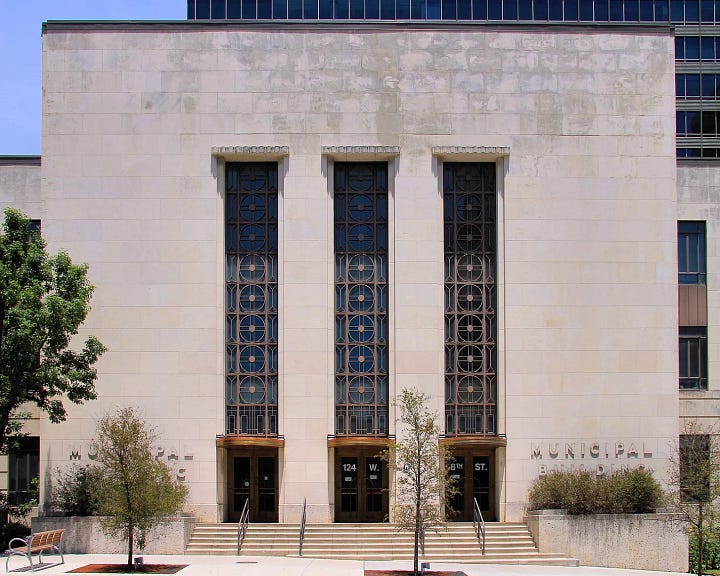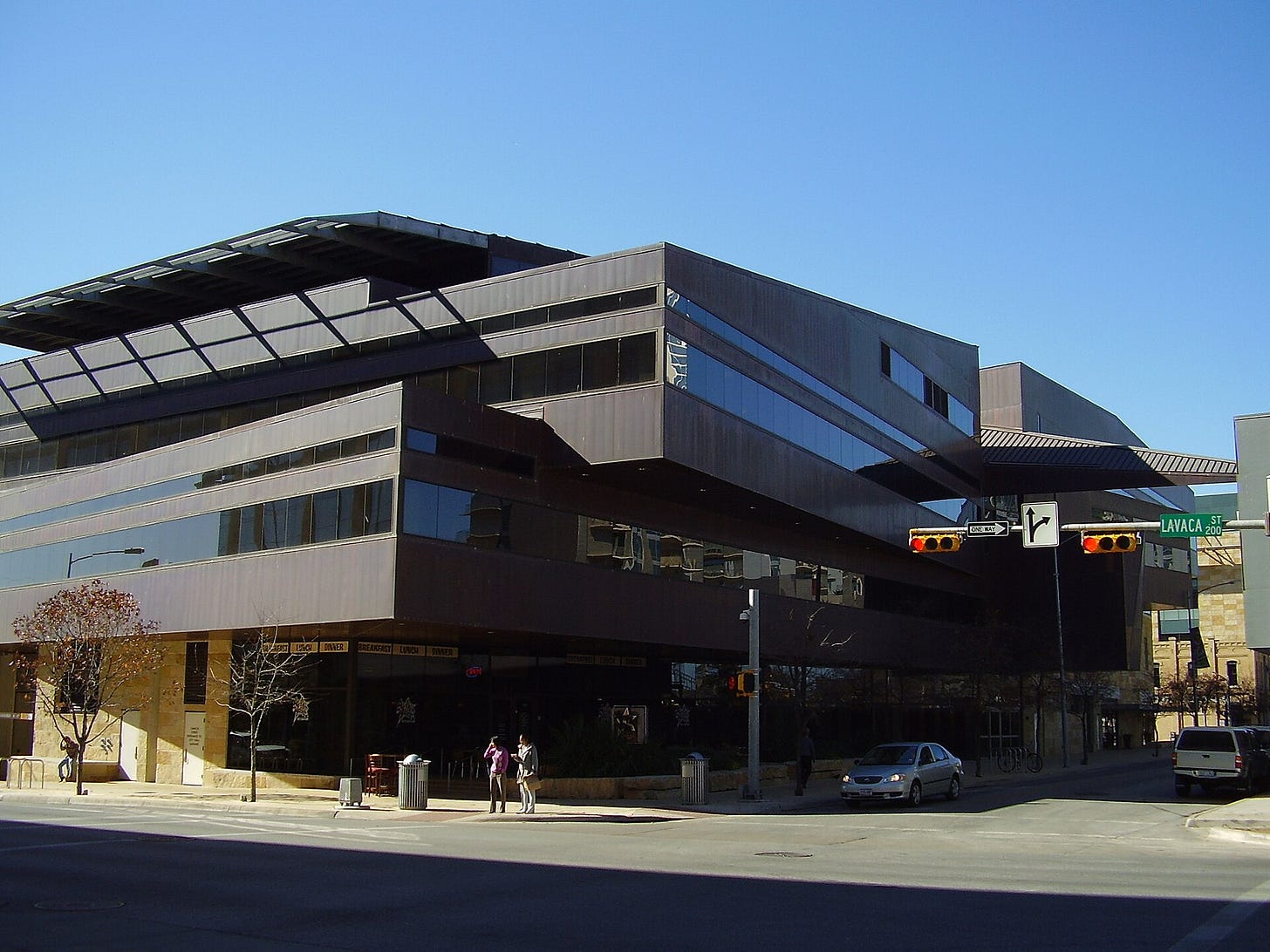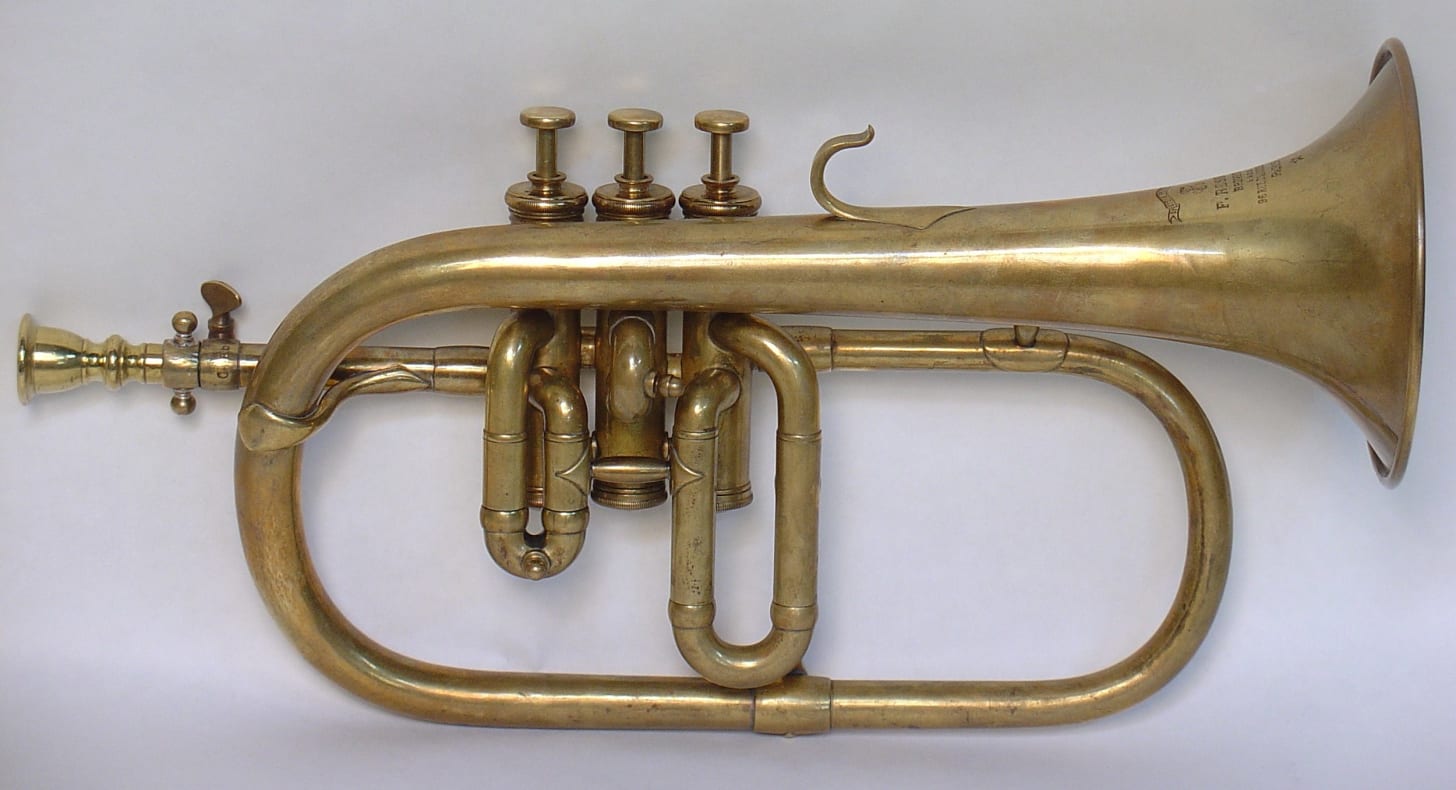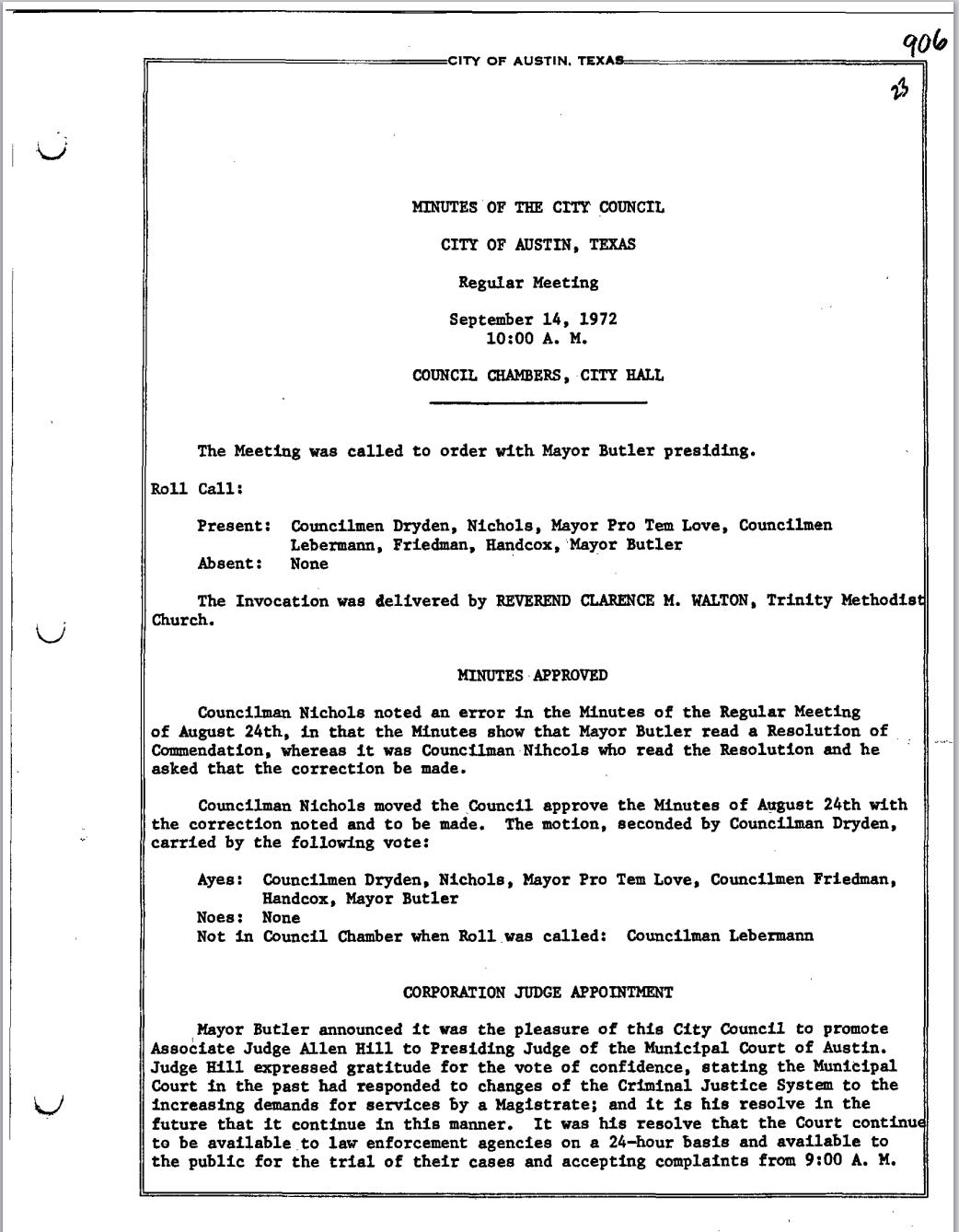In this post!
A mysterious sidewalk is an invitation.
The invitation is accepted. Investigative tools are acquired: a laptop and a fresh cup of coffee.
Answers are found collecting dust on Municipal Servers. We time travel to 1972.
Part One: A Municipal Mystery (Or, Looking For Cracked Doors)
We’ve a new spot for late night vegan burgers and wings in Austin, Texas. It’s a food truck called Nom Burger in East Austin. Last week while walking there from Coldtowne theater after catching a comedy show, I noticed the sidewalk beneath me was signed…
I snapped the photo above, briefly wondered who Terry Edwards was (or is), and soon my curiosity was eclipsed by my excitement for vegan wings.
Over the last few years, I’ve been trying to notice the “cracked doors” around me. Those little invitations into unexplored facts, mysteries, or simple history. It’s this impulse that made me notice, and photograph, the signed sidewalk that night. Perhaps this was a bit of careful graffiti, politely pressed into wet cement by a tagger named Terry. Or maybe the truth was stranger or more interesting. Maybe this was the first clue that might lead me to uncover a secret society, very much active in the year 2025, creating false histories for unknown aims…
Whatever the answer was, the signed sidewalk was certainly a cracked door and I intended to walk through it.
This week I did walk through. Armed with my laptop and a full cup of coffee in the early morning hours, I began my investigation to answer the question “who is Terry Edwards, and why did he sign the sidewalk in Austin, Texas in 1972?”
To begin, I did what any investigator might: I just googled for Terry Edwards. This is who I found:
Could this be the guy? A renowned flugelhorn player and musician known for his collaborations with David Bowie, Spiritualized, Nick Cave and many other famous artists?
I wondered why a 12 year old music protege from England was in Austin, Texas in 1972. A quick scan of wikipedia confirmed my suspicion that this was simply another Terry Edwards, a fun detour and new tune, but not my Terry.
***
I resumed my search, this time adding “1972” at the end of it.
And eureka! The first result was a link to Austin Gov’s official website, austin.gov1. I opened it up and was delighted to discover a 25 page PDF of scanned meeting minutes pounded out on a typewriter from some long gone summer when the Austin City Council convened.
Part Two: Where We’re Going We Don’t Need Roads (A minor detour back to the year 1972)
Before diving into the Minutes of the City Council meeting held within the Council Chambers of City Hall, let’s set the scene by exploring what was going on in 1972.


Firstly, it was a leap year. And depending on who’s counting, it was the longest year ever…
“Within the context of Coordinated Universal Time (UTC) it was the longest year ever, as two leap seconds were added during this 366-day year, an event which has not since been repeated.”
I’ve been down the road of trying to truly wrap my head around leap years, the Gregorian calendar, and all that jazz. I don’t feel like going back there today.
What else happened in 1972?
The Blue Marble photo was taken by the Apollo 17 crew. This was the final Apollo Mission and the final manned Moon landing ever. Sad.
Other noteworthy events of the longest year in history: a summer olympics in Munich remembered for a terrorist attack, the Vietnam war in full swing, the first commercial home video game console is released, the Watergate scandal begins in June, Nixon beats McGovern in November (a 19 year old Jake will eventually buy a lingering McGovern Campaign pin decades later in an antique store), environmentalism is gaining traction with the Clean Water Act and growing support for the EPA, Title IX became law prohibiting sex-based discrimination in federally funding schools, David Bowie releases The Rise and Fall of Ziggy Stardust and Neil Young releases Harvest. I will eventually fall in love with both of these records in my high school years.
Ok, vibe set, now back to the year 2025 where I am in my office with a half cup of coffee. I have just found the meeting minutes of an Austin City Council meeting from September 1972, which I am hopeful contain the secrets about Terry Edwards, a name imprinted into a sidewalk square in East Austin.

Part Three: Reconstructing History (Or, Terry Unmasked
I begin to read the meeting minutes, searching for my friend Terry.
On page four, I find him.
And he… was a construction company. And what’s more, he was unanimously awarded an $81,000 city contract to build sidewalks in East Austin. Terry Edwards was not an individual defacing public property, no, Terry Edwards was a business signing their work.
But now I had another question.. because the meeting minutes recorded the date as September 14th, 1972 but Terry’s sidewalk signature is clearly marked June 1972. Did Terry’s company ask for forgiveness instead of asking for permission to pave? Could this be a sidewalk scandal which occurred in the same month as the Watergate break in (possibly even the same day)? Might I have discovered a man with a time machine using his invention not to stop WWII or visit Cleopatra, but to deliver on his construction projects well ahead of schedule? Surely not.
I went searching for an answer and quickly found it, buried again in a twenty-something page PDF hosted on Austin City Government servers. This time, we eavesdrop on our favorite City Council in January 1972. Six months before the sidewalk I walked over was signed, and nine months before the $81,000 contract was awarded to Terry and co.
In this January meeting all of our favorite council members are present, with the exception of the honorable Councilman Lebermann2 who, we are told by Mayor Roy Butler, is running late again.
Shortly after the meeting begins — wait… someone opens the door and enters the chamber.
Ah! Councilman Lebermann, now that you are here we can begin.
On page 4 (yet again), it is recorded that the Austin City Council awarded Terry and his team another contract for sidewalk development, this time for $72,000. Here, finally, is the answer to the mundane municipal mystery of Terry Edwards, June 1972. The initial award was given in January 1972, the sidewalk was built and signed in June, and a second award was given to Terry in September 1972 (I’ve yet to stumble on the resulting sidewalks from that second award).
A few other “fun” facts:
The initial award was given the same month as the sinking of the RMS Queen Elizabeth in Hong Kong Harbor, which was in the process of being converted to a floating university! This was to be used for the “Semester at Sea” program, which is still running today.3
The meeting was also the exact day that President Zulfikar Ali Bhutto announced that Pakistan would immediately begin a nuclear weapons program.
…it was also my grandmother’s 33rd birthday.
and my uncle’s eighth.
Amidst the excitement of solving the sidewalk mystery I’d stumbled on, I searched for the answer to one last question: Where was Terry Edwards Construction now?
It’s with a saddened spirit that I report, they have since folded.
Part Four: Source Material (The Virtue of Old Media)
I’ve been fascinated with source material lately, which is a romantic way of saying I’ve been reading media from the 60s and 70s (more on that in the future). I’d forgotten just how much of a time capsule primary sources are: essays, journals, notes, and archives really do transport you back. It’s easy to read summaries and overviews of minor and major histories (and will be increasingly easy with AI helping compress decades into sentences), but I am reminded lately that nothing beats the visceral feeling of convening directly with source material.
It’s been a truly magical, almost surreal feeling reading essays and personal letters from the past. Each evening over the past week or so, I’ve sat down with my old magazines (low light and low music to set the mood) and traveled back in time to listen to dead or dying Americans share their ideas, fears, and predictions about their future and the future of their country. Sometimes their concerns or preoccupations seem myopic and turned out to be largely irrelevant, other times it feels like we almost solved large and pressing challenges that still dominate our collective psyche today. But I think part of the charm of wandering in the past is that in either case, some sort of meaningful mark remains in the present, whether left from a Presidential resignation forking reality or a simple name carved in a sidewalk.
Part Five: A Great Place to Exit the Ride
That was fun!
This small little sidewalk research project led me straight to more of these magic time capsule feelings. While largely inconsequential, I find exploring these “cracked doors” to be extremely worthwhile in and of themselves, especially when they are directly tied to the place you live or things you spend a lot of time with. It’s sort of like training your brain to notice the “side alleys”, those winking question marks hidden in plain sight all around us. I like to practice being curious.
Forevermore, when I walk the sidewalks of East Austin and see the name Terry Edwards, I’ll know exactly how it got there.
Austin’s current site appears to have launched in December 2011.
Lowell H Lebermann Jr. served three terms on the City Council. He passed away in July 2009. Mayor Roy Butler dubbed him "the Green Panther" because of his environmental efforts.














That portrait of Councilman Lebermann! What a guy.